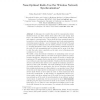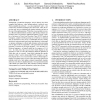82 search results - page 7 / 17 » Tight bounds for clock synchronization |
MST
2011
13 years 2 months ago
2011
In this paper we generalize the Continuous Adversarial Queuing Theory (CAQT) model [5] by considering the possibility that the router clocks in the network are not synchronized. W...
MOBICOM
2012
ACM
11 years 10 months ago
2012
ACM
In this paper, we propose a novel clock calibration approach called FLIGHT, which leverages the fact that the fluorescent light intensity changes with a stable period that equals...
ALGOSENSORS
2009
Springer
14 years 2 months ago
2009
Springer
In this paper we consider the model of communication where wireless devices can either switch their radios off to save energy (and hence, can neither send nor receive messages), o...
DAC
2009
ACM
14 years 8 months ago
2009
ACM
Traditionally, synchronous languages, such as Esterel, have been compiled into hardware, where timing analysis is relatively easy. When compiled into software ? e.g., into sequent...
IPPS
2009
IEEE
14 years 2 months ago
2009
IEEE
Failure detectors are a service that provides (approximate) information about process crashes in a distributed system. The well-known “eventually perfect” failure detector, 3P...


